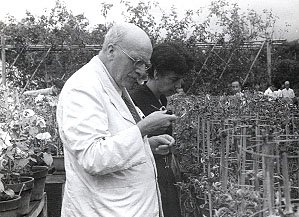J. B. S. Haldane
|
|
John Burdon Sanderson Haldane (November 5, 1892 – December 1, 1964), who normally used "J.B.S." as a first name, was a British geneticist and evolutionary biologist. He was one of the founders (along with Ronald Fisher and Sewall Wright) of population genetics.
| Contents |
Biography
Haldane was born in Edinburgh, the son of the medical doctor John Scott Haldane and his wife Louisa Kathleen Haldane, and descended from Scottish aristocrats (see Haldane family). His younger sister Naomi Mitchison would later become a writer. Haldane was educated at Dragon School, Eton College (which he hated) and at New College, Oxford.
During the First World War, Haldane served with the Black Watch in France and Iraq. He was initially Bombing Officer for the 3rd Bn before becoming a Trench Mortar Officer in the 1st. Whilst in the army, he became a socialist, writing "If I live to see an England in which socialism has made the occupation of a grocer as honourable as that of a soldier, I shall die happy".
Between 1919 and 1922 he was a fellow of New College, then moved to Cambridge University until 1932. He then moved to University College, London where he spent most of the remainder of his academic career. In the late 1950s he moved to India. The move was ostensibly a protest against the Suez War, but in reality had been on the cards for some while.
In 1924 Haldane met Charlotte Burghes (nee Franken) and the two later married. To do so Charlotte divorced her husband Jack Burghes, causing some controversy.
His famous book, The Causes of Evolution (1932), was a major work of what came to be known as the "modern evolutionary synthesis", reestablishing natural selection as the premier mechanism of evolution by explaining it in terms of the mathematical consequences of Mendelian genetics.
He was also a great science populariser, and was perhaps the Stephen Jay Gould or Richard Dawkins of his day. His essay, Daedalus or Science and the Future (1923), was remarkable in predicting many scientific advances but has been criticized for presenting a too idealistic view of scientific progress.
Haldane was himself a very idealistic man, and in his youth was a devoted Communist and author of many articles in The Daily Worker. Events in the Soviet Union, such as the rise of the anti-Mendelian agronomist Trofim Lysenko and the crimes of Stalin, caused him to break with the Communist Party later in life. He joined the Communist party in 1937 but left in 1950, shortly after having toyed with standing for Parliament as a Communist Party candidate.
He is also known for an observation from his essay, On Being the Right Size, which Jane Jacobs and others have since referred to as Haldane's principle. This is that sheer size very often defines what bodily equipment an animal must have: "Insects, being so small, do not have oxygen-carrying bloodstreams. What little oxygen their cells require can be absorbed by simple diffusion of air through their bodies. But being larger means an animal must take on complicated oxygen pumping and distributing systems to reach all the cells." The conceptual metaphor to animal body complexity has been of use in energy economics and secession ideas.
Haldane was friends with the author Aldous Huxley, and was the basis for the biologist Shearwater in Huxley's novel Antic Hay. Ideas from Haldane's Daedalus, such as ectogenesis (the development of fetuses in artificial wombs), also influenced Huxley's Brave New World.
Haldane had many students, the most famous of whom, John Maynard Smith, was perhaps also the one most like himself.
In one of the last speeches of his life, Biological Possibilities for the Human Species of the Next Ten Thousand Years (1963), Haldane coined the word "clone", from the Greek word for twig.
References
- Clark (1968) JBS: THe Life and Work of J.B.S. Haldane ISBN 0340044446
Publications
- Daedalus or Science and the Future, 1923
- The Causes of Evolution, 1932
- My Friend Mr Leakey, 1937
External links
- An online copy of Daedalus or Science and the Future (http://cscs.umich.edu/~crshalizi/Daedalus.html)
- A review (from a modern perspective) of The Causes of Evolution (http://cscs.umich.edu/~crshalizi/reviews/causes-of-evolution)
- You can see and hear J.B.S. Haldane speak during the introduction of the rather disturbing Soviet film Experiments in the Revival of Organisms (1940) (http://www.archive.org/movies/details-db.php?collection=prelinger&collectionid=19635)
| Topics in population genetics |
|---|
| Key concepts: Hardy-Weinberg law | Fisher's fundamental theorem | neutral theory |
| Selection: natural | sexual | artificial | ecological |
| Genetic drift: small population size | population bottleneck | founder effect |
| Founders: Ronald Fisher | J.B.S. Haldane | Sewall Wright |
| Related topics: evolution | microevolution | evolutionary game theory | fitness landscape |
| List of evolutionary biology topics |

